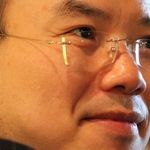Lecture / Paths to the Real
Paths to the Real: Processes of Contemporary Art in China
Friday, 3 June 2016, at 18:00
UGM| Maribor Art Gallery, Strossmayerjeva 6
Lecture by: Peng Feng, Ph.D. professor of aesthetics and art criticism at School of Arts, Peking University
Does contemporary art have stages or processes? According to Arthur Danto and Hans Belting, the answer should be no. Contemporary art manifests an awareness of a history of art but no longer carries it forward. In other words, contemporary art reaches post-historical stage of art. If they were right, it means that contemporary art in Northern America and Western Europe would not have history. But the situation in China and Eastern Europe, i.e. the post-socialist countries, is different. The beginning of contemporary art in post-socialist countries is clear. However, history of contemporary art in Eastern European countries is suspicious. The radical revolution in Eastern Europe changed the society immediately. Contemporary art in Eastern Europe has been soon absorbed by the international contemporary art and finally reached its post-historical stage. The situation in China is different not only from the post-modernist but also from the post-socialist view. Instead of radical revolution, China takes gradual reformation. Contemporary art has not yet won the fight with socialist realism. It has not yet accomplished its mission, which is to promote political reform and social change. Therefore, contemporary art in China is still in progress and has not yet reached its end, the so-called post-historical stage.
Peng Feng a Ph.D. of Peking University, is professor of aesthetics and art criticism at School of Arts, Peking University. Currently he is the vice dean of School of Arts and the director of the Center for Aesthetics and Aesthetic Education, Peking University. He is member of the executive committee of IAA and member of executive committee of China Society of Aesthetics. He has published 15 academic books including: The System of Contemporary Art Theory (Beijing: Peking University Press, 2016), Return of Presence: New Tendency in Philosophy and Contemporary Art (Beijing: China Federation of Literary and Art Circles Press, 2016), Aesthetic Venturing in the Arts (Beijing: Beijing Normal University Press, 2015), Modern Chinese Aesthetics (Nanjing: Fenghuang Press, 2014), Pervasion: China Pavilion at the 54th International Art Exhibition of La Biennale di Venezia (Beijing: People’s Art Press, 2012), Introduction to Aesthetics (Shanghai: Fudan University, 2011) and Return of Beauty: 11 Issues of Contemporary Aesthetics (Beijing: Peking University Press, 2009) and so on, 7 translation books including Nelson Goodman Languages of Art, Peter Kivy (ed.) The Blackwell Guide to Aesthetics, and Richard Shusterman Pragmatist Aesthetics and so on, and over 200 papers on aesthetics, theory of contemporary art, and history of Chinese philosophy. He is also a playwright, freelance art critic and curator of exhibitions at international level. He has curated over 200 art exhibitions including the China Pavilion at the 54th international art exhibition of Venice Biennale 2011, The 1st International Sculpture Exhibition of Datong Biennale 2011, and The 1st International Art Exhibition of China Xinjiang Biennale 2014. Recently, his musical The Red Lantern is travelling in China. A profile with the title “Peng Feng: Professional Professor, Amateur Curator” was published in Art in America, July 2013.
YOU ARE KINDLY INVITED! FREE ENTRY!
